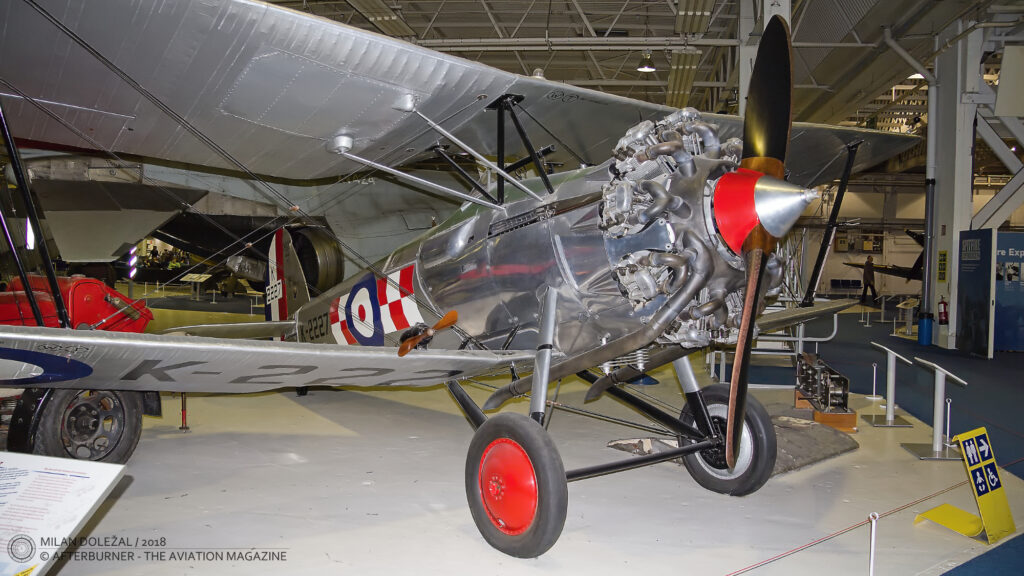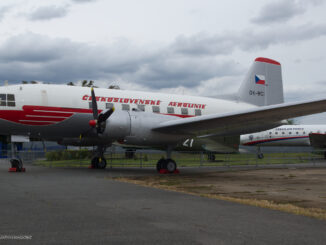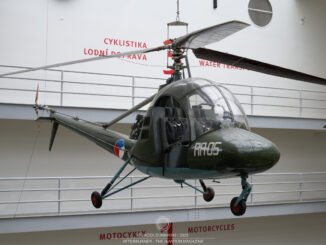 Bristol Bulldog Mk IIA (c/n 7446, formerly G-ABBB), exhibited at the Royal Air Force Museum in Hendon, London, July 2018.
Bristol Bulldog Mk IIA (c/n 7446, formerly G-ABBB), exhibited at the Royal Air Force Museum in Hendon, London, July 2018.
At the beginning of the 1920s, the Royal Air Force fighter tactics were focused on carrying long endurance patrol flights aimed for spotting potential enemy aircraft and then alarming nearby stationed fighter units. However, appearance of fast and powerful bomber aircraft made that tactics no longer effective. Aeroplanes such as Fairey Fox light bomber – able to carry up to 210 kg (460 lb) of bombs and powered by 850 hp V-12 Hispano-Suiza engine – could easily outclimb and outspeed any of the then existing RAF fighters.
As a result, the RAF was forced to implement a completely new operational requirements for its fighter aircraft. They were shortly after confirmed by the Air Ministry specification F.17/24 for the new single-seat, high-speed fighter aeroplane.
That specification resulted in creation of interesting studies of powerful biplane fighters, such as Gloster Guan and Gorcock. Both aircraft were powered by 12-cylinder Napier engines, however the powerplant caused several issues and finally those fighters never went beyond prototype stage. The third aircraft developed to meet the Air Ministry requirements was created by Frank Barnwell, at that time working as aircraft designer for the Bristol company. For his project, Barnwell used a different engine, more reliable V-12 Rolls-Royce Falcon. Regrettably, this was also the reason Bristol ceased further works on that development, as the company policy was to use only their own engine designs.
Two years later, the Air Ministry issued two new specifications – F.9/26 for ´day and night zone fighter´ and N.21/26 for ´Naval Fleet fighter´. Bristol decided to join that competition and assigned Barnwell the task of creating a fighter aircraft powered by Bristol-developed, nine-cylinder radial Mercury engine. Initially, the aeroplane was designated Type 105 and during its creation Barnwell was drawing freely on his previous, not realized project.
The fighter competition based on the aforementioned specifications from 1926 attracted several British aviation manufacturers that submitted approximately twenty proposals. Unsurprisingly, the aircraft proposed by Bristol was judged as made for the F.17/24 specification rather than for the current ones. In consequence, the company was asked to re-develop the aeroplane. That new fighter was designated Type 107 (aka Bullpup) and built in one prototype example. However, the design was not accepted by the Air Ministry.
Nevertheless, Bristol considered the Type 105 so promising that the company decided to continue development of that aircraft on its own expenses. In consequence, Barnwell built a biplane of all-metal construction, covered with fabric and equipped with Bristol Jupiter nine-cylinder radial engine. On 17th May 1927, the aircraft successfully performed its maiden flight and received the name Bulldog.
Shortly after, the Bulldog was sent to the RAF for evaluation and, despite being rejected at its project stage, was approved for further testing, together with Hawker Hawfinch. One of the advantages of the Bristol aircraft, pointed out by the RAF test pilots, was its exceptional manoeuvrability.
In January of 1928, Bristol introduced an upgraded variant of the fighter, designated Bulldog Mk II (company name Type 105A). That version of the aeroplane was finally approved by the Air Ministry as the new aircraft for the RAF and the first order for twenty-five aircraft was placed shortly after.
The first Bulldog fighters were delivered to the RAF in May of 1929. A few further orders from the RAF were placed soon and finally there were approximately three hundreds of those aeroplanes delivered to British fighter squadrons – the first ninety-two of them were in the initial, Mk II version, then followed by modernized Bulldog Mk IIA.
Regrettably, one of the best-known facts from the Bulldogs service with the RAF is related to an aviation accident. On 14th December 1931, a fighter pilot from No. 23 Squadron performed low-level aerobatics for Reading Aero Club at Woodley Airfield. During the display, his Bulldog Mk IIA K-1676 touched the ground with left wing tip and then crashed. The young pilot was badly injured and both his legs were amputated, one above and another below the knee. Nevertheless, Douglas Bader – as he was that unlucky pilot – never gave up and not only returned to duty but shortly became one of the most famous air aces of the World War II, credited with 22 aerial victories.
The Bristol Bulldog never saw any combat with the RAF, being withdrawn from active service in 1937. However, the aeroplane was exported to few countries all over the world and operationally used there.
In 1936, eleven Bulldogs were acquired by the Spanish Republican Air Force from Latvia and during the Spanish Civil War opened the combat record of that type of aircraft. The Bristol Bulldog was also used by the Finnish Air Force in the Winter War, then continued operational service as training aeroplane during the so-called Continuation War.
The aircraft exhibited in the RAF Museum in Hendon is one of only two survived Bulldogs in the world. It was built in 1930 and then used by Bristol for demonstration purposes. Therefore, it was included in the civil aircraft register as G-ABBB.
In 1938, the aeroplane was donated for museum purposes, at that time being exhibited in the Science Museum. After the World War II, the Bulldog was restored to airworthy condition and performed displays at many air shows. Regrettably, in 1964 the aeroplane crashed in Farnborough – the pilot was just slightly wounded, but the Bulldog had to be written off.
In the early 1990s, the remains of that aeroplane were used by the RAF Museum to restore the Bristol Bulldog for exhibition purposes. Fortunately, more than 50% of the original parts survived and in March of 1999 the Bulldog went on a public display at Hendon.
The aeroplane is currently presented with markings of No. 56 Squadron RAF, carrying the serial number K-2227.



